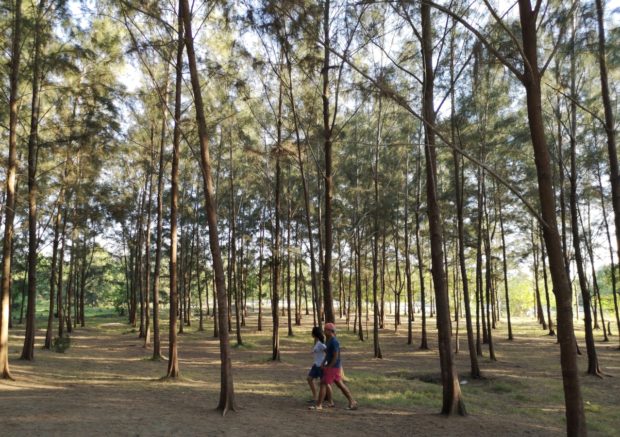
AGOO’S AGOHO Agoho trees serve as Instagram-worthy background for visitors of the Agoo Eco-Fun World in La Union province. Agoo town’s name is derived from its agoho trees, many of them growing along the highway leading to the town center. —EV ESPIRITU
AGOO, La Union, Philippines — You know you are in Agoo, 220 kilometers from Metro Manila, when you pass through the highway lined with agoho trees (Casuarina equisetifolia), after which the town was named. But there are thousands more of the towering trees at the Agoo Eco-Fun World, where you can walk, rest or nap.
The place allows visitors to commune with nature—unfurling a mat or spreading a towel, hanging a hammock, stretching out or simply staring into the long stretch of the pale green needles of the trees.
On a breezy day, they can enjoy the pine scent and listen to the singing or whistling pine trees.
“They are called the whistling pine,” said Sunshine de la Cruz, the municipal information officer, referring to the agoho trees.The trees stand in straight rows at the park along the coastal village of Sta. Rita facing the Lingayen Gulf.
An enchanting yet calming vista welcomes visitors who enter the gate to a four-lane concrete pathway cutting across the tree plantation and leading to the beach, where late afternoons offer mesmerizing sunsets.
REST Guests are welcome to stay overnight at cottages put up by the Department of Environment and Natural Resources or enjoy the breeze from huts lining the shorelines of Agoo.
Man-made forest
“This is a man-made forest,” De la Cruz said of the park with a lagoon framed by trees and Mt. Katayagan in the east.
Cows graze on grasslands, quenching their thirst in a pond bordered by thick forests. Close to the sea are mangroves, where migratory birds roost when the sun starts to go down.
The beach area has picnic huts for rent. The bigger huts may be used for team-building activities, De la Cruz said.
There are no concrete structures of any sort inside the park that could spoil nature.
With no food stores, visitors are advised to bring snacks or lunch but to never leave any garbage behind.
Smoking is strictly prohibited.
Wilderness
It may take much imagination that less than 10 years ago, the area was wilderness, De la Cruz said. Much earlier, the park was part of the sea, as evidenced by the seawall near the gate.
“The sea retreated by about a kilometer,” De la Cruz said.
In 2011, the Department of Environment and Natural Resources (DENR) started to reforest the place under its national greening program (NGP).
According to Maximo Soriano, La Union provincial environment and natural resources officer, the park is part of the Agoo-Damortis Protected Landscape and Seascape (ADPLS), which covers 10,774.68 hectares as core zone and 135 ha as buffer zone.
Of this area, only 3 percent is land and the rest is marine ecosystem.
“Under the NGP, 9 ha were reforested with ear leaf acacia, mangroves and agoho,” Soriano said. Government and nongovernmental organizations took part in the reforestation efforts.
The agoho trees planted in the park are those that thrive in hot weather and sandy area, and are different from the variety found in Baguio City. Still, there was a need to put garden soil around the saplings so they won’t wobble, Soriano said.
In 2013, the DENR’s Protected Area Management Board (PAMB) and the local government of Agoo entered into a memorandum of agreement, tasking the town with managing the part of the ADPLS which straddles the town.
The area was developed into the Agoo Eco-Fun World by the town government.
COMMUNING WITH NATURE People aching for time away from the hustle and bustle of city life can commune with nature in Agoo town’s coastal parks. They can enjoy quiet time with a view of mangroves and by watching sea birds dart through the waters, or by mingling with local fishermen and their families unloading their fresh catch. —PHOTOS BY EV ESPIRITU
Eco lodges
Not far is another park maintained by the PAMB. Unlike in the ecopark, there are facilities there which can be used by tourists—eco lodges, a view deck and a public toilet.
Visitors may also pitch tents in the tree-covered campsite.
A bamboo boardwalk starts from the old seawall and circles thick mangroves where migratory birds seek warmth at night. Visitors may observe and enjoy the birds from the viewdeck, said Felix Olivas Jr. of the PAMB staff.
Entrance fee in the two parks is P15, which goes to the environment projects of two communities, Sta. Rita Central and Sta. Rita West.